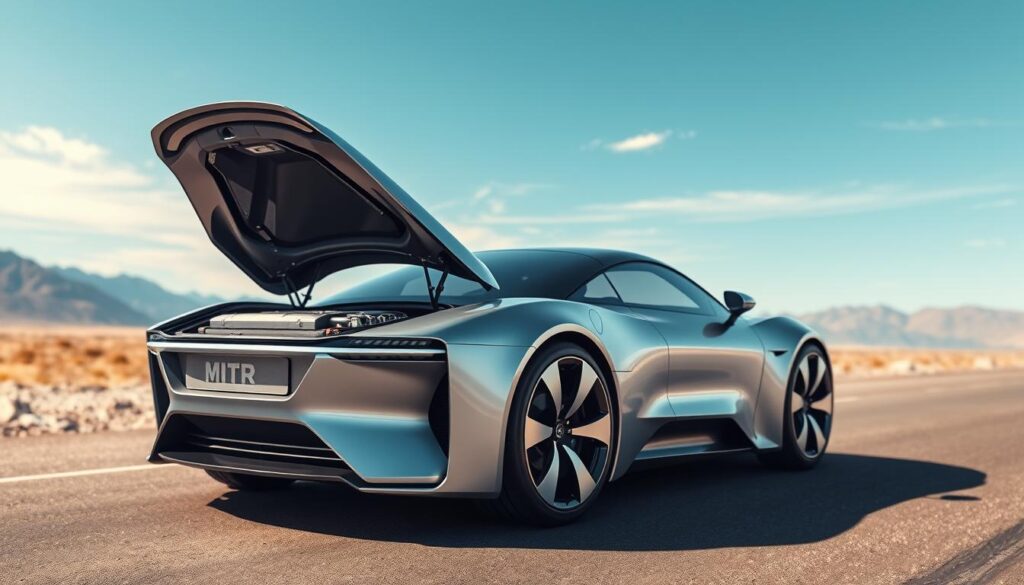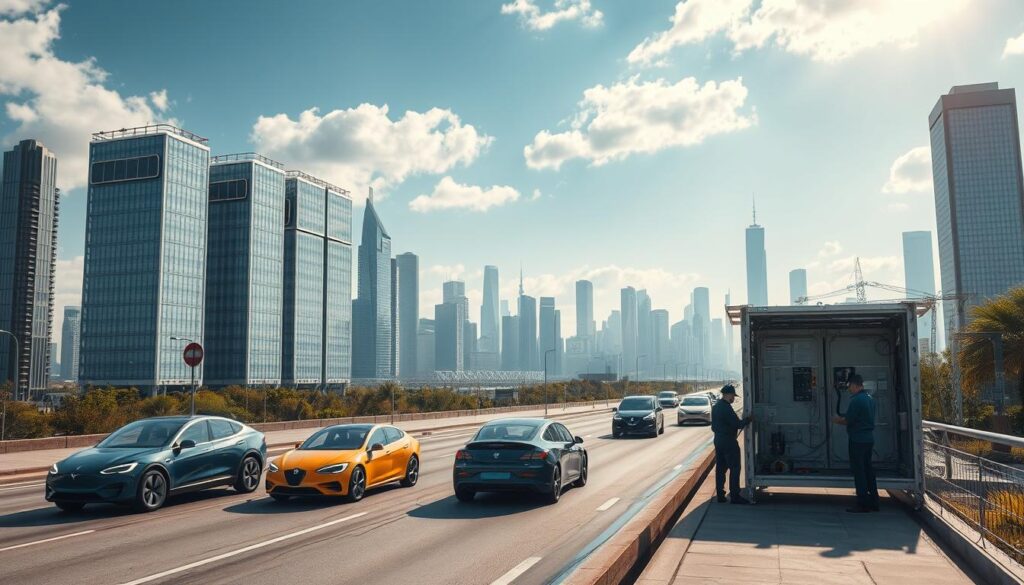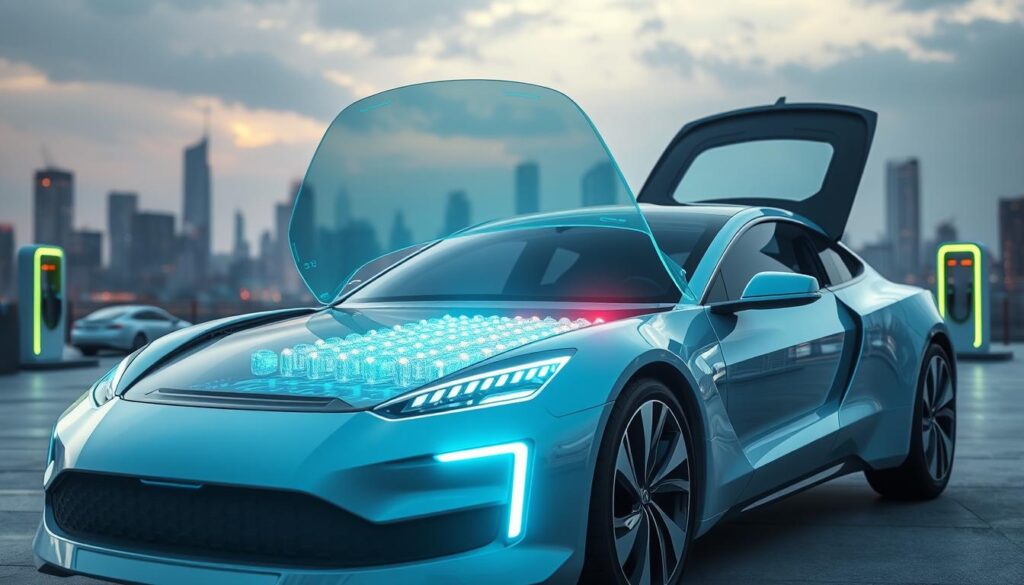The car industry is moving fast towards the future, and new battery tech for cars is leading the change. Electric vehicles (EVs) are set to make up almost a third of all car sales soon. This means next-generation battery solutions for vehicles are crucial. Countries like the United States and the European Union are pushing for more electric cars with new policies and incentives.
Lithium-ion batteries are still the top choice, used in everything from storing energy for the grid to our personal gadgets. But, there’s always more to come. Researchers are working hard to make batteries that hold more charge, charge faster, and are cheaper. The goal is to make electric cars the norm, and we’re getting closer thanks to new battery tech.
Key Takeaways
- Lithium-ion battery technology, while prevalent, is undergoing significant refinement to meet escalating demand.
- Policy and economic incentives are turbocharging the EV market, subsequently elevating the need for innovative battery solutions.
- Research into high-density and fast-charging battery alternatives is pivotal to the widespread adoption of EVs.
- Experts are advocating for battery advancements to support broader applications, such as improving grid storage capacities.
- With a global push towards sustainable transportation, the race for the next breakthrough in battery technology is on.
The Momentum of Electric Vehicle Adoption and Battery Demand
The push for sustainability is making electric vehicles (EVs) more popular. This is thanks to policy-driven battery technology advancements and more people caring about the environment. EVs are changing the car industry fast.
Strategic policies and incentives are changing the game. With global electric vehicle market growth on the rise, EV numbers are expected to jump from 30 million to 240 million by 2030. This means a 30% increase each year, showing a big move towards electric cars.
Global Sales Trends in Electric Vehicles
EV sales trends are looking up, with a big increase in people choosing electric cars. By 2030, over 40 million electric light-duty vehicles are expected to be sold. This shows people want cleaner cars as they learn more about climate change.
Policy Acceleration for EV Growth
Worldwide, governments are pushing for more electric cars. California’s plan to sell only zero-emission cars by 2035 is a big step. With $7.5 billion for charging stations, they’re tackling the big issue of charging spots.
Battery Technologies: Lithium-Ion and Their Applications
The key to electric cars is the latest car battery technology, mainly lithium-ion batteries. They’re used not just in cars but also for storing energy from the grid. Even though they’re leading, finding new materials like lithium and cobalt is a challenge. Advancements in battery technology are crucial. They improve EVs and help the industry move towards a sustainable future.
As more people buy electric cars, it’s clear that new battery tech and strong policies are key. The rise of EVs shows a big change in how we think and act, moving us towards a cleaner planet.
Emergence of Solid-State Batteries in the EV Landscape
Solid-state batteries are changing the game in electric vehicles (EVs). They are becoming more popular as people want better and safer cars. These batteries bring many benefits that could make EVs better for everyone.
Benefits Over Liquid Electrolyte Batteries
Solid-state batteries beat traditional ones in many ways. They pack more energy and are safer. They can hold about 400 Wh per kilogram, up from 250 Wh in lithium-ion batteries. This means EVs can go farther on one charge, helping to overcome range anxiety.
Also, solid-state batteries don’t have flammable liquids inside. This greatly lowers the chance of fires, making cars safer.
Advancing the Safety Features with Solid-State Technology
Solid-state batteries are safer than lithium-ion ones. They use a ceramic electrolyte that doesn’t catch fire easily. This reduces the risk of overheating and fires.
These batteries also work well in extreme temperatures, from -30°C to 100°C. This makes them reliable in different weather conditions.
Partnerships and Progress in Commercialization
Many car makers and tech firms are teaming up to use solid-state batteries. For instance, BMW and QuantumScape are working together to improve EVs. They want to make charging faster and batteries last longer.
Companies like Honda are also making solid-state batteries more affordable. They hope to make this tech available to more people.
| Parameter | Lithium-Ion Batteries | Solid State Batteries |
|---|---|---|
| Energy Density (Wh/kg) | 250 | 400 |
| Typical Degradation Cycles | 1,000-2,000 | Up to 10,000 |
| Charge Speed to 80% Capacity | 36 minutes | 10-15 minutes |
| Thermal Stability Range (°C) | 0°C to 50°C | -30°C to 100°C |
Innovative Automobile Battery Solutions: Sodium-Ion Batteries
Sodium-ion batteries are becoming key in making cars more sustainable and affordable. As electric vehicles (EVs) become more popular, there’s a big need for new battery types. These should be cheaper than the old lithium-ion batteries.
Cost-Effective Alternatives to Lithium-Ion
The car industry is looking for new options, and sodium-ion batteries are a good choice. They’re cheaper because sodium is easy to find. This makes them a smart choice for both car makers and buyers.
Potential and Limitations in EV Applications
Sodium-ion batteries have big advantages but face some challenges. They don’t hold as much energy as lithium-ion batteries, which means cars can’t go as far on one charge. But, things are getting better, with plans to improve by 2026.
Another issue is charging time. These batteries can’t charge as fast as some electric cars need. They also need better materials to work well on a large scale. But, they do well in cold weather, which is important for many places.
The future of cars might include sodium-ion batteries. Companies like Farasis Energy and Siro are working on making them better. Their work could make electric cars more affordable and better for the planet.
Cutting-Edge Vehicle Battery Advancements for Grid Storage
The future of car batteries is moving towards innovative automobile battery solutions for grid storage. These solutions use tech from electric vehicles to improve grid storage. This shift helps make the grid more stable and supports renewable energy by storing energy better.
Real-world examples show how these technologies can change the game. For instance, nanoBolt lithium tungsten batteries charge quickly, and zinc-manganese oxide batteries store more energy without costing more. Also, organosilicon electrolyte batteries are safer than lithium-ion ones, which is key for storing energy on a large scale.
Now, we’re seeing EV battery tech being used more in grid storage. Companies like GM Energy and Tesla are leading the way with mega packs. These projects show how car battery tech is becoming a key part of solving energy storage problems.
Using EV battery tech in grid storage is a big step forward. Companies like Form Energy and ESS are making big moves with iron-air and iron-flow batteries. This shows we’re moving towards big, affordable energy storage solutions.
The goal is to make energy storage better and cheaper. By making batteries more efficient, the energy sector could earn more than the car industry from these innovations. This is key to using more sustainable energy and balancing the demand for it.
In summary, as modern advancements in automotive batteries grow, they’re becoming key for grid storage. They help use more renewable energy, make the grid safer, and are changing the energy world for the better.
Advanced Electric Car Battery Technology: Tweaking Lithium-Ion Chemistries
There’s a big push to make electric car batteries better and cheaper. This is happening by improving lithium-ion chemistries. These changes aim to boost energy storage, safety, and battery life. This is key for more people to use electric vehicles.
Mitigating Material Price Volatility
Changes in raw material prices have led to big improvements in electric car battery tech. The goal is to use less expensive and less volatile materials like cobalt and nickel. By doing this, companies can make batteries that work well but cost less. This makes electric cars more affordable and practical.
The Rise of Lithium Iron Phosphate (LFP) Batteries
Lithium iron phosphate (LFP) batteries are becoming more popular because they’re cheaper and safer. They’re great for electric cars because they stay cool and last a long time. In just a few years, LFP batteries have gone from making up 10% of the market to about 40%.
As LFP battery tech gets better, they’ll be even more useful for electric cars.
| Year | Global EV Sales Market Share | LFP Battery Market Share |
|---|---|---|
| 2018 | 4% | 10% |
| 2022 | 14% | 40% |
LFP batteries are becoming a big deal in the battery market. They show how electric car battery tech is always getting better. As the electric car industry grows, using advanced batteries like LFP will keep it at the forefront of tech. This helps make driving more sustainable and efficient.
Revolutionary Car Battery Developments: Shifts in Anode Materials
The evolution of electric vehicle batteries has seen big changes, especially in anode materials. These changes are key to making batteries more efficient and charge faster. This marks a big shift in revolutionary car battery developments.
Silicon anodes are a big deal in these changes. They could greatly improve how batteries work. Silicon can store up to 50% more energy than old graphite anodes, setting new standards.
The Potential of Silicon Anodes
Silicon anodes could lead to super-fast charging for electric vehicles. EVs could go from 20% to 80% charge in just about 11 minutes. Companies like Nexeon are leading the way, making lots of high-quality silicon anode material every year.
Graphite Anodes: The Current Standard and Its Evolution
Even as silicon gets more attention, graphite anode enhancements are still key. Graphite is the main part of most lithium-ion batteries, known for being stable and efficient. Adding silicon to graphite is showing promising improvements in how long batteries last and how well they work.
These advances in anode materials are vital for better battery efficiency and what electric vehicles can do. For more on electric mobility, check out EV Next Gen. They focus on sustainable transportation solutions.
The mix of graphite anode enhancements and silicon is more than just an upgrade. It’s a new definition of battery technology that meets the needs of electric vehicles and renewable energy. As we move forward with revolutionary car battery developments, it’s clear the future of transportation is changing fast.
Next-Generation Battery Solutions for Vehicles: Policy Implications
The Inflation Reduction Act has greatly impacted electric car battery technology. It’s now driving sustainable growth in EV manufacturing. With funding and incentives, next-generation battery solutions for vehicles are getting a boost. This is making the sector more competitive and innovative.
Strategic policies are key to boosting domestic battery production. They help create jobs and keep the U.S. competitive in clean energy. By focusing on local production, we ensure a strong supply chain for electric vehicles. This supports the goals of the Inflation Reduction Act, which invests in clean energy projects like battery technology.
The law also helps by getting critical materials like lithium, cobalt, and nickel from allies. This reduces our reliance on unstable international markets and boosts national security. Companies like Redwood Materials and Li-Cycle are leading the way. They’re making battery parts from recycled materials, promoting a circular economy in battery production.
| Battery Type | Advantages | Policy Support |
|---|---|---|
| Solid-State Batteries | Higher energy density, faster recharging, reduced overheating risk | High, due to safety and performance benefits |
| Lithium Iron Phosphate (LFP) | Cost-effective, safer alternative to Li-ion | Moderate, supports cost reduction strategies |
| Sodium-Ion Batteries | Uses abundant sodium, competing with Li-ion if capacity enhances | Emerging, potential for future policy incentives |
These policies are speeding up the development of next-generation battery solutions for vehicles. They also set a global standard for clean energy in manufacturing. As the industry grows, ongoing support from government and laws will be crucial. This will help us face global competition and technological changes.
State-of-the-Art Automotive Battery Technology and Recycling
The focus on sustainability in automotive battery technology is growing. As electric vehicles become more common, the need for better battery production and recycling grows. New recycling and production methods are being developed to tackle these issues. These efforts are making the industry more efficient and setting the stage for a circular economy in car manufacturing.
Scaling Up Recycling Efforts
Advanced battery recycling is leading the way in these changes. Companies like Ascend Elements can extract 98% of materials from old batteries. Redwood Materials and Cirba Solutions are building new recycling plants in places like Nevada, Ohio, and South Carolina. This is driven by both economic and environmental reasons.
According to Alexis Georgeson of Redwood Materials, recycling batteries is profitable and crucial for meeting the demand for battery materials. It also gets support from federal incentives to help domestic supply chains.
Production and Reuse Impact from Policy Shifts
Policy changes are key to promoting sustainable battery production and material reuse. The U.S. government is investing in creating a battery-recycling system. The ReCell Center, backed by the government, is leading research to make EV battery packs cheaper and reduce production costs.
The focus on the EverBatt model and Direct Recycling of Materials shows a big shift towards sustainability. This is important for a future where advanced automotive battery technology and protecting the environment go hand in hand.











